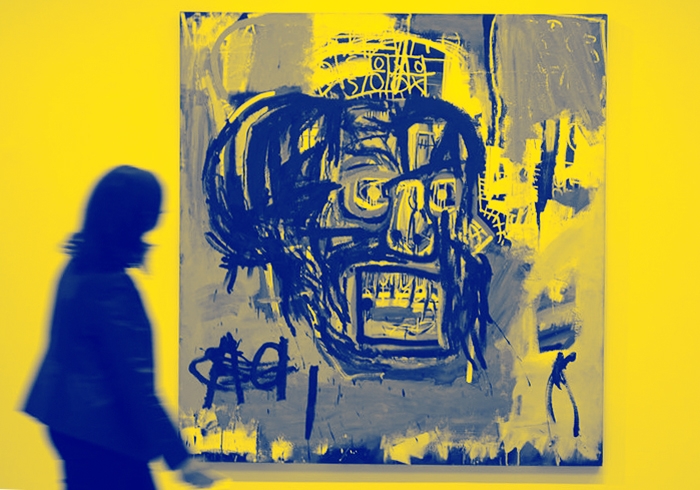There is something a tad incredible, or unbelievable, about the recent record-setting $110.5 million sale of an untitled Jean-Michel Basquiat painting at Sotheby’s New York on 18 May. First there is the fact the work was bought by a young Japanese billionaire. With its echoes of the late-1980s, who cannot but think that this is a marker of hyper art-market inflation, now updated for the Instagram age (Instagram is where the buyer, Yusaku Maezawa, chose to first display his new trophy; does he even need to take possession now?).
Then there is the fact that it is a Basquiat painting that broke the record (previously held by an Andy Warhol) for the highest price paid for a single work by an American artist at auction. The artist’s expressionist style and his tragic – and so capital-R Romantic – biography have long conspired on a sales-pitch (and racial) mythology of transcendent value to which the wealthy appear uniquely susceptible. In the wake of the controversy over Dana Schutz’s Open Casket (2016) painting of the tortured and murdered Emmett Till at the Whitney Biennial, it’s notable that so far this Basquiat sale has sparked relatively little commentary about the spectacularisation of black-American culture and history (is it out of the realm of possibility that the ‘skull’ so many claim to see in this picture is instead a black man’s angst-ridden and cringing visage?).
Finally there is the context: this melodrama of high-commercial theatre is taking place against the backdrop of the train wreck of the Trump presidency, for which incredulousness has become something like our nation’s mental steady-state, regardless of your politics: if you’re on the right, you’re witnessing a ‘slow motion coup d’etat’ – so wrote an anonymous commentator in The Federalist – if you’re on the left, you can’t quite believe that your hopes and dreams of the big-‘I’ (Impeachment) might actually be coming true.
This melodrama of high-commercial theatre is taking place against the backdrop of the train wreck of the Trump presidency
There is a barely-believable vulgarity to it, and here I’m not talking about the political handwringing on the right and palm-rubbing on the left. The optics of the Basquiat sale are of the ‘and the band played on’ variety, optics not unfamiliar to, say, the pictures of this year’s White House Correspondents’ Association Dinner, when the media and celebrity elite got together in effete black-tie to toast them- selves and to roast an absent Donald Trump, who one-upped this proclaimed ‘opposition party’ by heading to Pennsylvania and holding a political rally that could only have offered more ‘red meat’ to his voting base had he air-gunned Trump-brand T-bone steaks into the bleachers. Bob Woodward and Carl Bernstein, the reporters who broke Watergate and so Nixon’s presidency, were onstage in Washington while baby-Benito whipped up the animal spirits in Harrisburg. Was it a scene straight out of Philip Roth’s 2004 The Plot Against America? Who could tell?
When faced with such unbelievability, the brand-aware hunt for labels. I’ve heard many people resort to calling all of this ‘surreal’, but I don’t think André Breton would agree; Georges Bataille might – he had a greater affection for the proximities of shit and saintly Shinola – but neither would have paid a cent for a Basquiat. To my mind, it’s all closer to science fiction, or rather to the ‘speculative fiction’ that writers such as Margaret Atwood and Kim Stanley Robinson practice, fictions that could very well take place (or have taken place) in our current or near-future reality, as opposed to those (such as ones that feature dragons and boy wizards) that could not.
At this point it is perhaps old hat to mention the timeliness of Atwood’s 1985 The Handmaid’s Tale’s release as an original streaming series on Hulu (writing that feels like a piece of speculative fiction all to itself ); or that George Orwell’s 1984 rocketed to the top of Amazon’s bestseller list shortly after Trump’s adviser Kellyanne Conway introduced the world to ‘alternative facts’ to explain the record crowds and rays of sunshine that had (in fact not) graced her ‘dear leader’ on inauguration day; or – perhaps less old hat – that Atwood began her book in 1984 while travelling the duelling utopias of West and East Berlin.
Personally, I’m more taken with Tom Perrotta and Damon Lindelof ’s The Leftovers on HBO (based on Perrotta’s 2011 novel by the same name). Briefly, the conceit of The Leftovers is to answer this question: what would happen to our social fabric if two percent of the population one day simply disappeared? The mystery of this perhaps-rapturous-perhaps-not ‘sudden departure’ is of little import; how characters build various different mental apparatuses and social technologies to deal with it is. When faced with the truly inexplicable, the novel and show suggest, our belief and value systems succumb to some fatal exception error, and upon reboot, some mixture of extremism and banality ensues.
What is a sale of a $110.5m painting but a mixture of extremism and banality in an age of the unbelievable?
From the Summer 2017 issue of ArtReview
